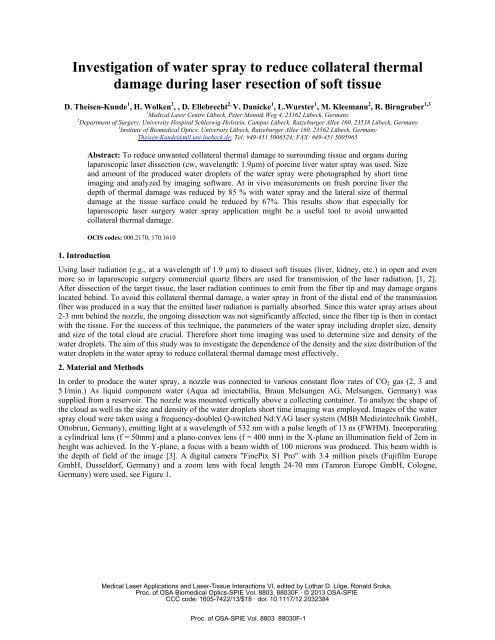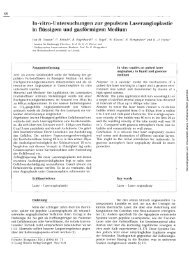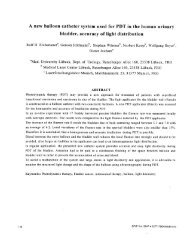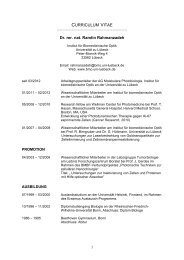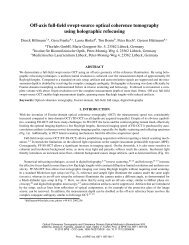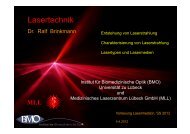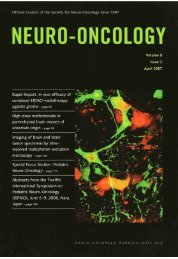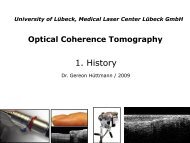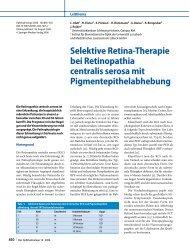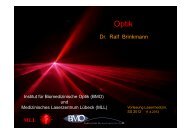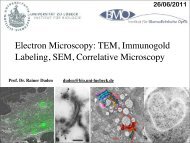Investigation of water spray to reduce collateral thermal damage ...
Investigation of water spray to reduce collateral thermal damage ...
Investigation of water spray to reduce collateral thermal damage ...
You also want an ePaper? Increase the reach of your titles
YUMPU automatically turns print PDFs into web optimized ePapers that Google loves.
<strong>Investigation</strong> <strong>of</strong> <strong>water</strong> <strong>spray</strong> <strong>to</strong> <strong>reduce</strong> <strong>collateral</strong> <strong>thermal</strong><strong>damage</strong> during laser resection <strong>of</strong> s<strong>of</strong>t tissueD. Theisen-Kunde 1 , H. Wolken 2 , , D. Ellebrecht 2, V. Danicke 1 , L.Wurster 1 , M. Kleemann 2 , R. Birngruber 1,31 Medical Laser Centre Lübeck, Peter Monnik Weg 4, 23562 Lübeck, Germany2 Department <strong>of</strong> Surgery, University Hospital Schleswig-Holstein, Campus Lübeck, Ratzeburger Allee 160, 23538 Lübeck, Germany3 Institute <strong>of</strong> Biomedical Optics, University Lübeck, Ratzeburger Allee 160, 23562 Lübeck, GermanyTheisen-Kunde@mll.uni-luebeck.de; Tel: #49-451 5006524; FAX: #49-451 5005965Abstract: To <strong>reduce</strong> unwanted <strong>collateral</strong> <strong>thermal</strong> <strong>damage</strong> <strong>to</strong> surrounding tissue and organs duringlaparoscopic laser dissection (cw, wavelength: 1.9µm) <strong>of</strong> porcine liver <strong>water</strong> <strong>spray</strong> was used. Sizeand amount <strong>of</strong> the produced <strong>water</strong> droplets <strong>of</strong> the <strong>water</strong> <strong>spray</strong> were pho<strong>to</strong>graphed by short timeimaging and analyzed by imaging s<strong>of</strong>tware. At in vivo measurements on fresh porcine liver thedepth <strong>of</strong> <strong>thermal</strong> <strong>damage</strong> was <strong>reduce</strong>d by 85 % with <strong>water</strong> <strong>spray</strong> and the lateral size <strong>of</strong> <strong>thermal</strong><strong>damage</strong> at the tissue surface could be <strong>reduce</strong>d by 67%. This results show that especially forlaparoscopic laser surgery <strong>water</strong> <strong>spray</strong> application might be a useful <strong>to</strong>ol <strong>to</strong> avoid unwanted<strong>collateral</strong> <strong>thermal</strong> <strong>damage</strong>.OCIS codes: 000.2170; 170.16101. IntroductionUsing laser radiation (e.g., at a wavelength <strong>of</strong> 1.9 µm) <strong>to</strong> dissect s<strong>of</strong>t tissues (liver, kidney, etc.) in open and evenmore so in laparoscopic surgery commercial quartz fibers are used for transmission <strong>of</strong> the laser radiation, [1, 2].After dissection <strong>of</strong> the target tissue, the laser radiation continues <strong>to</strong> emit from the fiber tip and may <strong>damage</strong> organslocated behind. To avoid this <strong>collateral</strong> <strong>thermal</strong> <strong>damage</strong>, a <strong>water</strong> <strong>spray</strong> in front <strong>of</strong> the distal end <strong>of</strong> the transmissionfiber was produced in a way that the emitted laser radiation is partially absorbed. Since this <strong>water</strong> <strong>spray</strong> arises about2-3 mm behind the nozzle, the ongoing dissection was not significantly affected, since the fiber tip is then in contactwith the tissue. For the success <strong>of</strong> this technique, the parameters <strong>of</strong> the <strong>water</strong> <strong>spray</strong> including droplet size, densityand size <strong>of</strong> the <strong>to</strong>tal cloud are crucial. Therefore short time imaging was used <strong>to</strong> determine size and density <strong>of</strong> the<strong>water</strong> droplets. The aim <strong>of</strong> this study was <strong>to</strong> investigate the dependence <strong>of</strong> the density and the size distribution <strong>of</strong> the<strong>water</strong> droplets in the <strong>water</strong> <strong>spray</strong> <strong>to</strong> <strong>reduce</strong> <strong>collateral</strong> <strong>thermal</strong> <strong>damage</strong> most effectively.2. Material and MethodsIn order <strong>to</strong> produce the <strong>water</strong> <strong>spray</strong>, a nozzle was connected <strong>to</strong> various constant flow rates <strong>of</strong> CO 2 gas (2, 3 and5 l/min.) As liquid component <strong>water</strong> (Aqua ad iniectabilia, Braun Melsungen AG, Melsungen, Germany) wassupplied from a reservoir. The nozzle was mounted vertically above a collecting container. To analyze the shape <strong>of</strong>the cloud as well as the size and density <strong>of</strong> the <strong>water</strong> droplets short time imaging was employed. Images <strong>of</strong> the <strong>water</strong><strong>spray</strong> cloud were taken using a frequency-doubled Q-switched Nd:YAG laser system (MBB Medizintechnik GmbH,Ot<strong>to</strong>brun, Germany), emitting light at a wavelength <strong>of</strong> 532 nm with a pulse length <strong>of</strong> 13 ns (FWHM). Incorporatinga cylindrical lens (f = 50mm) and a plano-convex lens (f = 400 mm) in the X-plane an illumination field <strong>of</strong> 2cm inheight was achieved. In the Y-plane, a focus with a beam width <strong>of</strong> 100 microns was produced. This beam width isthe depth <strong>of</strong> field <strong>of</strong> the image [3]. A digital camera "FinePix S1 Pro" with 3.4 million pixels (Fujifilm EuropeGmbH, Dusseldorf, Germany) and a zoom lens with focal length 24-70 mm (Tamron Europe GmbH, Cologne,Germany) were used, see Figure 1.Medical Laser Applications and Laser-Tissue Interactions VI, edited by Lothar D. Lilge, Ronald Sroka,Proc. <strong>of</strong> OSA Biomedical Optics-SPIE Vol. 8803, 88030F · © 2013 OSA-SPIECCC code: 1605-7422/13/$18 · doi: 10.1117/12.2032384Proc. <strong>of</strong> OSA-SPIE Vol. 8803 88030F-1
4. DiscussionIt was shown that short time imaging setup with a laser pulse length <strong>of</strong> 13 ns is sufficient <strong>to</strong> analyze the parameters<strong>of</strong> the <strong>water</strong> <strong>spray</strong> cloud with respect <strong>to</strong> the number and the size <strong>of</strong> the <strong>water</strong> droplets. At the focal plane in theX-plane, however, only a depth <strong>of</strong> field <strong>of</strong> about 100 µm was achieved. Therefore not all individual <strong>water</strong> droplets(especially in high density <strong>water</strong> <strong>spray</strong> clouds) could be resolved completely. However this pho<strong>to</strong>graphic analysismethod can be used <strong>to</strong> optimize the geometric construction <strong>of</strong> the nozzle for the desired effect.Using a cw Thulium Laser system at power <strong>of</strong> 20 and 40 W for s<strong>of</strong>t tissue dissection, it was shown in the animalstudy that the reduction <strong>of</strong> the <strong>thermal</strong> <strong>collateral</strong> <strong>damage</strong> was 85 % in depth and 67% in diameter respectively at20 W laser power. At a higher power level <strong>of</strong> 40W the reduction decreased, only 72% in depth and 38% in diameterwere achieved. To increase the efficiency <strong>of</strong> the <strong>water</strong> <strong>spray</strong> at a power level <strong>of</strong> 40 W the nozzle may have <strong>to</strong> beredesigned. Especially for laparoscopic laser surgery <strong>water</strong> <strong>spray</strong> application might be a useful <strong>to</strong>ol <strong>to</strong> avoidunwanted <strong>collateral</strong> <strong>thermal</strong> <strong>damage</strong>.5. AcknowledgementThis work was supported by a grant <strong>of</strong> the Central Innovation Program for SMEs (ZIM) <strong>of</strong> the Federal Ministry <strong>of</strong>Economics and Technology <strong>of</strong> Germany as a project <strong>of</strong> the Association <strong>of</strong> Industrial Research Consortia "Ot<strong>to</strong> vonGuerike" (AiF) (grant number KF2341202AK0).6. References[1] D. Theisen-Kunde, S. Tedsen, C. Doehn, D. Jocham and I. Kausch von Schmeling, "Comparison between a 1.92-μm fiber laser and a standardHF-dissection device for nephron-sparing kidney resection in a porcine in vivo study," Lasers in Medical Science, Volume 26, S. 509-514,2011.[2] M. H. Bui, A. Breda, D. Gui, J. Said, and P. Schulam, "Less smoke and minimal tissue carbonization using a thulium laser for laparoscopicpartial nephrec<strong>to</strong>my without hilar clamping in a porcine model," J Endourol, Volume 21, S. 1107-11, Sep 2007.[3] J. Noack, R. Tönnis, K. Hohla, R. Birngruber, and A. Vogel, "Influence <strong>of</strong> ablation plume dynamics on the formation <strong>of</strong> central islands inExcimer Laser pho<strong>to</strong>refractive keratec<strong>to</strong>my", Ophthalmology, Volume 104, S. 823-30, 1997.Proc. <strong>of</strong> OSA-SPIE Vol. 8803 88030F-4


